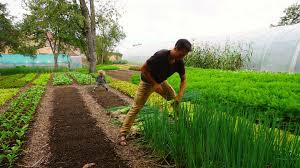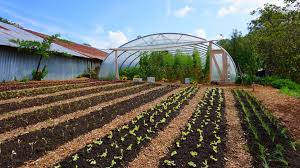Starting a farm can be an exciting venture, full of opportunities to connect with the land and cultivate a sustainable livelihood. To embark on this journey, one must first consider the type of farming they wish to pursue. Whether it’s crop cultivation, livestock rearing, or a combination of both, a clear vision is crucial.
Understanding the local climate and soil conditions is paramount. Different crops thrive in different environments, so it’s essential to choose crops that align with the region’s natural characteristics. Conducting soil tests can provide valuable insights into nutrient levels, helping optimize the land for productivity.
Once the type of farming is chosen, acquiring suitable land becomes the next step. Assessing factors such as accessibility, water availability, and proximity to markets can aid in selecting the right location. Securing a reliable water source is especially critical for sustaining crops and livestock throughout the seasons.
Investing in quality farming equipment is a wise decision. Tractors, plows, and other essential tools can significantly ease the workload and enhance efficiency. Additionally, learning about modern farming techniques and incorporating sustainable practices can contribute to long-term success.
Developing a comprehensive business plan is essential for managing finances and setting realistic goals. Consideration should be given to budgeting for seeds, livestock, equipment, and ongoing operational costs. Farmers should also explore marketing strategies to effectively sell their products and connect with the local community.
Building a support network within the farming community can provide valuable insights and assistance. Attending local agricultural events, joining farming associations, and participating in workshops can help newcomers gain knowledge and establish meaningful connections.
Diversification is a key strategy for a successful farm. Growing a variety of crops or raising multiple types of livestock can mitigate risks associated with market fluctuations and environmental factors. Additionally, exploring niche markets or specialty products can create unique selling points.
Embracing technology can enhance farm management. Implementing precision farming techniques, utilizing data analytics, and incorporating automation where possible can optimize operations and increase overall efficiency. Staying informed about advancements in agricultural technology is crucial for staying competitive in the ever-evolving farming landscape.
Patience and resilience are virtues in farming. Unforeseen challenges, such as weather fluctuations, pest outbreaks, or market shifts, may arise. Being adaptable and willing to learn from experiences are key attributes for overcoming obstacles and ensuring the long-term sustainability of the farm.
Starting a farm is a multifaceted journey that requires careful planning, a deep understanding of the land, and a commitment to sustainable practices. By embracing the challenges and opportunities that come with farming, individuals can contribute to the growth of local agriculture while cultivating a fulfilling and rewarding lifestyle.
Read Also: Black Honey Bees: A Closer Look
Benefits of Starting a Farm

Starting a farm offers numerous benefits that extend beyond the satisfaction of cultivating the land. Here are some key advantages:
1. Connection to Nature: Farming provides a direct connection to the natural environment. Working the land allows individuals to appreciate the changing seasons, understand weather patterns, and witness the cycle of life firsthand.
2. Sustainable Living: Operating a farm allows for a more sustainable lifestyle. By growing one’s food and possibly raising livestock, individuals can reduce their reliance on external food sources, contributing to a more self-sufficient and environmentally friendly way of life.
3. Healthy Lifestyle: Farming is inherently physical work, involving activities such as planting, harvesting, and tending to animals. This active lifestyle can contribute to improved physical health, providing exercise and reducing the risks associated with sedentary living.
4. Community Engagement: Farms often become integral parts of local communities. Selling produce at farmers’ markets or participating in community-supported agriculture programs fosters community engagement and allows farmers to establish meaningful connections with neighbors.
5. Entrepreneurial Opportunities: Starting a farm opens the door to various entrepreneurial opportunities. Beyond selling crops or livestock, farmers can explore value-added products, agro-tourism, or educational programs, adding multiple revenue streams to their operation.
6. Food Security: Operating a farm can enhance personal and community food security. Producing a variety of crops or raising livestock provides a diverse and reliable source of food, reducing dependence on external food supply chains.
7. Environmental Stewardship: Farmers play a crucial role in environmental stewardship. Implementing sustainable farming practices, such as organic farming or agroforestry, can contribute to soil conservation, biodiversity preservation, and overall environmental health.
8. Learning and Growth: Farming is a continuous learning process. Whether it’s mastering new agricultural techniques, staying updated on market trends, or adapting to unforeseen challenges, the journey of running a farm provides constant opportunities for personal and professional growth.
9. Cultural Preservation: In many cases, farming involves the preservation of cultural practices and traditions. Passing down agricultural knowledge from one generation to the next helps maintain cultural heritage and contributes to the overall diversity of farming practices.
10. Quality of Life: For many, the decision to start a farm is driven by a desire for a simpler and more fulfilling life. The tranquility of rural living, coupled with the sense of purpose derived from working the land, can significantly enhance one’s overall quality of life.
In addition, starting a farm offers a myriad of benefits, from a deeper connection to nature and improved physical health to entrepreneurial opportunities and contributions to community and environmental well-being.
Read Also: Flowers for Honey Bees
Guide to Starting a Farm

Starting a farm involves a series of steps and considerations. Here’s a guide to help you navigate the process:
1. Define Your Purpose: Clarify your goals and reasons for starting a farm. Are you focused on crop cultivation, livestock, or a combination of both? Understand what you aim to achieve with your farm.
2. Conduct Research: Learn about the local climate, soil conditions, and agricultural zoning regulations in your area. Research the types of crops or livestock that thrive in your region.
3. Choose the Right Location: Select a suitable piece of land based on factors like accessibility, water availability, and proximity to markets. Consider the size of the farm, and ensure it meets your current and future needs.
4. Develop a Business Plan: Create a comprehensive business plan that outlines your budget, financial projections, and operational strategies. Identify potential challenges and plan for contingencies.
5. Acquire Necessary Skills and Knowledge: Familiarize yourself with modern farming techniques, sustainable practices, and equipment operation. Attend workshops, courses, or seek guidance from experienced farmers to enhance your skills.
6. Secure Funding: Assess your financial resources and explore funding options. This may include personal savings, loans, grants, or partnerships. Ensure you have sufficient capital to cover start-up costs and initial operational expenses.
7. Obtain Equipment and Supplies: Purchase or lease the necessary farming equipment, such as tractors, plows, and irrigation systems. Source quality seeds, livestock, or other inputs required for your chosen farming activities.
8. Plan Crop Rotation or Livestock Rotation: Develop a plan for crop rotation or livestock rotation to optimize soil health and prevent pest or disease buildup. This helps maintain the long-term productivity of the farm.
9. Implement Sustainable Practices: Embrace sustainable farming practices to minimize environmental impact. This may include organic farming methods, water conservation, and responsible use of resources.
10. Build Infrastructure: Construct the essential infrastructure, such as barns, fences, and storage facilities, based on the needs of your farm. Ensure that the infrastructure is durable and meets safety standards.
11. Establish Marketing Strategies: Develop marketing strategies to sell your products. Explore local farmers’ markets, community-supported agriculture (CSA) programs, or partnerships with local businesses. Leverage online platforms for broader reach.
12. Network and Seek Support: Connect with other farmers, join agricultural associations, and attend industry events. Building a support network can provide valuable advice, assistance, and a sense of community.
13. Stay Informed and Adapt: Stay updated on industry trends, technological advancements, and changes in regulations. Be willing to adapt your farming practices based on new information and experiences.
14. Monitor Finances and Performance: Regularly track your finances and evaluate the performance of your farm. Adjust your strategies as needed to ensure financial sustainability and long-term success.
15. Embrace Challenges and Enjoy the Journey: Farming comes with challenges, but resilience and a positive mindset are crucial. Embrace the learning curve, celebrate successes, and enjoy the rewarding journey of nurturing the land.
Remember that starting a farm is a dynamic process that requires continuous learning and adaptation. By following these steps and remaining dedicated to your vision, you can lay the foundation for a successful and fulfilling farming venture.
Read Also: The Impact of Waste to Compost Business
